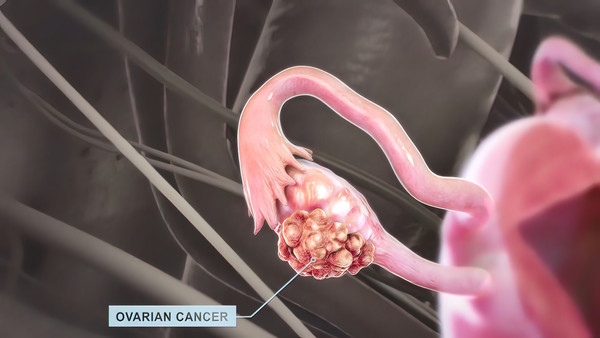If you're a woman in your 40s or older and you're experiencing symptoms such as bloating, indigestion, and weak urine flow, one cancer you should be aware of is ovarian cancer. It's worth noting that this cancer is often diagnosed in about 50 percent of cases at stage 3 or 4.
Appearing on Seoul National University Bundang Hospital’s (SNUBH) YouTube channel, Professor Kim Ki-dong of the Department of Obstetrics and Gynecology discussed the symptoms of ovarian cancer.
"You may have symptoms like a sense of fullness, difficulty in digestion, and changes in urination patterns, but since these symptoms are not specific to ovarian cancer, early diagnosis is often challenging, and cancer may only be detected in advanced stages," he said.
"If you experience persistent symptoms, even if they are non-specific, it is advisable to seek medical attention and undergo appropriate testing."

Diagnosis
Ovarian cancer originates in the ovaries, vital organs in female reproductive and hormone regulation. It predominantly affects women in their 40s, 50s, and 60s, with approximately 3,000 new cases reported annually in Korea. Ovarian cancer is classified into three main types based on the tissue where the cancer forms: epithelial ovarian cancer, germ cell cancer, and sex stromal cancer. Epithelial ovarian cancer, which develops in the epithelial cells on the ovary's surface, accounts for over 90 percent of ovarian cancer cases.
Genetic factors, particularly mutations in the BRCA genes, play a significant role in the development of ovarian cancer.
Professor Kim emphasizes that individuals with BRCA gene mutations, as exemplified by U.S. actress Angelina Jolie, have an elevated risk of developing ovarian cancer, even at a younger age. Additionally, besides genetics, a woman's risk of ovarian cancer increases with the frequency of ovulation.
"When a woman becomes pregnant, her risk of ovarian cancer decreases significantly due to the cessation of ovulation. One childbirth alone can reduce the risk by approximately 10 percent compared to women who have never given birth, and with three births, the risk can be lowered by as much as 50 percent," explained Kim.
He further noted that breastfeeding after childbirth or using oral contraceptives also contributes to a reduced risk of ovarian cancer since they effectively suppress ovulation.
Early detection is crucial
Ovarian cancer, like other types of cancer such as stomach, colon, and breast cancer, is classified into stages 1 through 4 to determine its severity. In stage 1, cancer cells are confined to the ovaries. Stage 2 indicates that ovarian cancer has spread to the pelvis. Stage 3 involves the presence of metastases in the abdominal cavity or lymph nodes, while stage 4 signifies that the cancer has extended beyond the abdominal cavity to areas like the liver, brain, lungs, and more.
"Detection in stage 1 offers a favorable treatment outcome with a low recurrence rate, but if ovarian cancer is diagnosed after stage 3, the prognosis becomes less favorable," Professor Kim said.
Indeed, when ovarian cancer is detected and treated at an early stage, it exhibits a cure rate of over 80 to 90 percent. However, for advanced cases in stage 3 or 4, the five-year survival rate drops significantly to only 44 percent.
Kim pointed out, "Ovarian cancer presents a high mortality rate primarily because it lacks obvious symptoms in its early stages, and most patients only seek medical attention once the disease has already advanced to stage 3 or beyond." This is why the overall five-year survival rate for ovarian cancer stands at 62 percent, he said.
Many patients with ovarian cancer respond favorably to chemotherapy, with the tumor disappearing in 70 to 80 percent of cases. However, a significant number of these patients eventually face recurrence, and with each recurrence and subsequent treatment with chemotherapy, the tumor may develop resistance and become more challenging to manage.
Regrettably, at present, there is no reliable method for early detection of ovarian cancer. Several studies have attempted early detection through regular ultrasounds and blood tests, but there is insufficient evidence to suggest that ovarian cancer screening is effective for women at an average risk, Professor Kim said.
Treatment
The current standard treatment for ovarian cancer involves surgery to remove as many tumors as possible, followed by chemotherapy.
Professor Kim explained, "The treatment approach is determined based on the extent of cancer cell spread and the biopsy results after surgery."
In cases where the cancer cells have spread extensively, chemotherapy may be administered before surgery, he added.
Typically, surgical treatment for ovarian cancer entails the removal of various structures, including the uterus, both ovaries, fatty tissue, and enlarged lymph nodes. Additionally, if metastatic tumors are found in other areas such as the colon, small intestine, spleen, liver, or diaphragm, surgical intervention may extend to these locations as well.
Even following surgery, there is the possibility of residual cancer cells that may not be visible. To address this, chemotherapy can be administered.
In addition to chemotherapy, maintenance therapy with anti-cancer medications like PARP inhibitors plays a significant role in enhancing treatment outcomes.
Professor Kim noted, "Combining angiogenesis inhibitors with chemotherapy can effectively lower the risk of recurrence."
He also highlighted recent research findings that demonstrated a remarkable 70 percent reduction in the risk of recurrence among ovarian cancer patients with genetic mutations who received targeted therapies aimed at inducing cancer cell death.
Participation in clinical studies of new drugs for ovarian cancer can also potentially lead to better outcomes than standard treatment.
"New anti-cancer drugs are being actively developed in recent years, so if you have hope and treat actively, you can expect good results," Professor Kim said.

